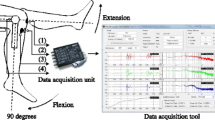Abstract
Analysis of disorders in the human body using computational methods had given greater impact for diagnosis and cure. Vibroarthrographic signals are noninvasive modality that considers vibrations that are obtained from the human knee joints as a signal and analyzes the stability of the human knee joint. The signal analysis reaches the complete classification phase using the machine learning strategies in which feature engineering plays a vital role. The clinical cloud is used by the medical organizations to maintain the patient’s record, and the sample data are transferred to the specific diagnosis device where there is a need for cloud security measures. In this article, VAG signals are transferred from the model clinical cloud using security measures and analyzed by considering the number of feature selection and feature extraction strategies which are further justified by the classification results obtained through the machine learning algorithms. This security-enhanced research paves way for the clinicians and researchers to choose the appropriate security measures, feature analysis, and classifiers to obtain better results. A benchmark dataset that has 89 VAG signals are utilized for constructing the feature strategies, and the results are discussed.






Similar content being viewed by others
Availability of data and materials
Not applicable.
References
Alphonse B, Rajagopal V, Sengan S et al. (2021) Modeling and multi-class classification of vibroarthographic signals via time domain curvilinear divergence random forest. J Ambient Intell Human Comput. https://doi.org/10.1007/s12652-020-02869-0
Athavale Y, Krishnan S (2020) A telehealth system framework for assessing knee-joint conditions using vibroarthrographic signals. Biomed Signal Process Control 55:101580, ISSN 1746–8094. https://doi.org/10.1016/j.bspc.2019.101580
Athavale Y, Krishnan S (2018) A device-independent efficient actigraphy signal-encoding system for applications in monitoring daily human activities and health. Sensors 18:2966. https://doi.org/10.3390/s18092966
Balajee A, Venkatesan R (2021) Machine learning based identification and classification of disorders in the human knee joint—computational approach. Soft Comput 25:13001–13013. https://doi.org/10.1007/s00500-021-06134-0
Befrui N, Elsner J, Flesser A et al (2018) Vibroarthrography for early detection of knee osteoarthritis using normalized frequency features. Med Biol Eng Comput 56:1499–1514. https://doi.org/10.1007/s11517-018-1785-4
Dwivedi, AK, Kaliyaperumal Subramanian U, Kuruvilla J et al. (2023) Time-series data prediction problem analysis through multilayered intuitionistic fuzzy sets. Soft Comput 27:1663–1671. https://doi.org/10.1007/s00500-022-07053-4
Hjorth B (1970) EEG analysis based on time domain properties. Electroencephalogr Clin Neurophys 29(3):306–310, ISSN 0013–4694. https://doi.org/10.1016/0013-4694(70)90143-4
Kręcisz K, Bączkowicz D (2018) Analysis and multiclass classification of pathological knee joints using vibroarthrographic signals. Comput Methods Prog Biomed 154:37–44, ISSN 0169–2607. https://doi.org/10.1016/j.cmpb.2017.10.027
Krishnan S, Rangayyan RM, Bell GD, Frank CB (2000) Adaptive time-frequency analysis of knee joint vibroarthrographic signals for noninvasive screening of articular cartilage pathology. IEEE Trans Biom Eng 47(6):773–783
López-Pérez M, Morales-Álvarez P, Cooper LAD, Molina R, Katsaggelos AK (2023) Deep Gaussian processes for classification with multiple noisy annotators. Application to breast cancer tissue classification. IEEE Access 11:6922–6934. https://doi.org/10.1109/ACCESS.2023.3237990
Łysiak A, Fron A, Bączkowicz D, Szmajda M (2020) Vibroarthrographic signal spectral features in 5-class knee joint classification. Sensors 20:5015. https://doi.org/10.3390/s20175015
Nalband S, Sundar A, Prince AA, Agarwal A (2016) Feature selection and classification methodology for the detection of knee-joint disorders. Comput Methods Prog Biomed 127:94–104. https://doi.org/10.1016/j.cmpb.2016.01.020
Nalband S, Valliappan CA, Prince AA, Agrawal A (2018) Time-frequency based feature extraction for the analysis of vibroarthographic signals. Comput Electrical Eng 69:720–731. https://doi.org/10.1016/j.compeleceng.2018.02.046
Rangayyan RM, Wu YF (2008) Screening of knee-joint vibroarthrographic signals using statistical parameters and radial basis functions. Med Biol Eng Comput 46:223–232. https://doi.org/10.1007/s11517-007-0278-7
Rangayyan RM, Krishnan S, Bell GD, Frank CB, Ladly KO (1997) Parametric representation and screening of knee joint vibroarthrographic signals. IEEE Trans Biomed Eng 44(11):1068–1074. https://doi.org/10.1109/10.641334. (PMID: 9353986)
Santhakumar D, Logeswari S (2020) Efficient attribute selection technique for leukaemia prediction using microarray gene data. Soft Comput 24:14265–14274. https://doi.org/10.1007/s00500-020-04793-z
Shen Y, Rangayyan RM, Bell GD, Frank CB, Zhang YT, Ladly KO (1995) Localization of knee joint cartilage pathology by multichannel vibroarthrography. Med Eng Phys 17(8):583–594. https://doi.org/10.1016/1350-4533(95)00013-d. (PMID: 8564153)
Tavathia S, Rangayyan RM, Frank CB, Bell GD, Ladly KO, Zhang YT (1992) Analysis of knee vibration signals using linear prediction. IEEE Trans Biomed Eng 39(9):959–970. https://doi.org/10.1109/10.256430. (PMID: 1473825)
Tingting Mu, Nandi AK, Rangayyan RM (2008) Screening of knee-joint vibroarthrographic signals using the strict 2-surface proximal classifier and genetic algorithm. Comput Biol Med 38(10):1103–1111. https://doi.org/10.1016/j.compbiomed.2008.08.009
Venkatesh K, Narasimhan D (2022a) Revealing the novel precise subset identification and deduplication of audio substance over the shared public environment. J Supercomput 78:11856–11872. https://doi.org/10.1007/s11227-022-04317-6
Venkatesh K, Narasimhan D (2022b) MLPD: a multi-layer protection with deduplication technique to preserve audio file transmission over the public domain. Soft Comput 26:3573–3585. https://doi.org/10.1007/s00500-022-06801-w
Vigorita VJ (1999) Orthopaedic pathology. Lippincott Williams and Wilkins, Philadelphia
Wu Y, Krishnan S (2009) Classification of knee-joint vibroarthrographic signals using time-domain and time-frequency domain features and least-squares support vector machine. In: 2009 16th International conference on digital signal processing, pp 1–6, https://doi.org/10.1109/ICDSP.2009.5201156
Yang S, Cai S, Zheng F, Yunfeng Wu, Liu K, Meihong Wu, Zou Q, Chen J (2014) Representation of fluctuation features in the pathological knee joint vibroarthrographic signals using kernel density modeling method. Med Eng Phys 36(10):1305–1311. https://doi.org/10.1016/j.medengphy.2014.07.008
Funding
No funding was received to assist with the preparation of this manuscript.
Author information
Authors and Affiliations
Contributions
All authors contributed equally.
Corresponding author
Ethics declarations
Conflict of interest
The authors declare that they have no conflict of interest.
Ethical approval
Not applicable.
Additional information
Publisher's Note
Springer Nature remains neutral with regard to jurisdictional claims in published maps and institutional affiliations.
Rights and permissions
Springer Nature or its licensor (e.g. a society or other partner) holds exclusive rights to this article under a publishing agreement with the author(s) or other rightsholder(s); author self-archiving of the accepted manuscript version of this article is solely governed by the terms of such publishing agreement and applicable law.
About this article
Cite this article
Balajee, A., Murugan, R. & Venkatesh, K. Security-enhanced machine learning model for diagnosis of knee joint disorders using vibroarthrographic signals. Soft Comput 27, 7543–7553 (2023). https://doi.org/10.1007/s00500-023-07934-2
Accepted:
Published:
Issue Date:
DOI: https://doi.org/10.1007/s00500-023-07934-2




